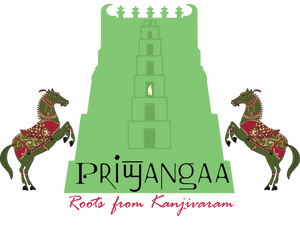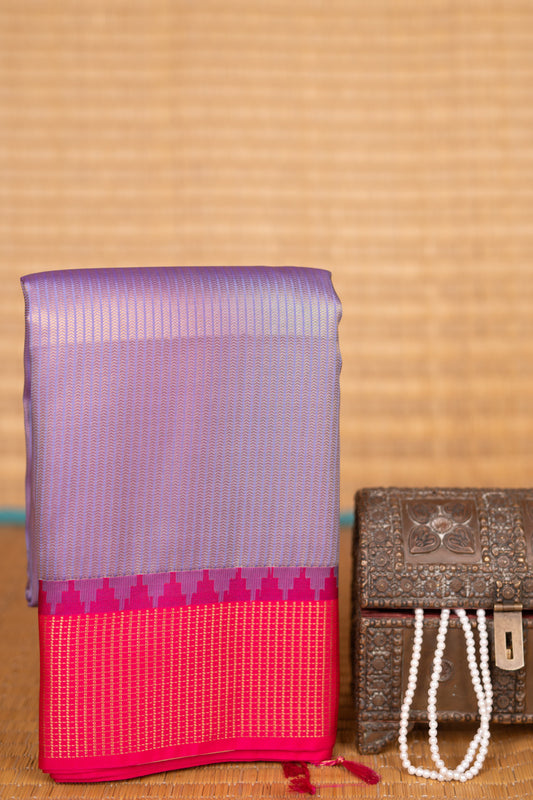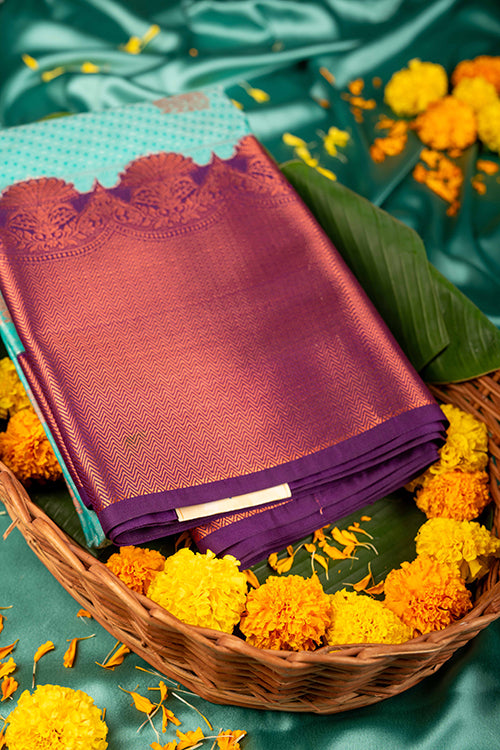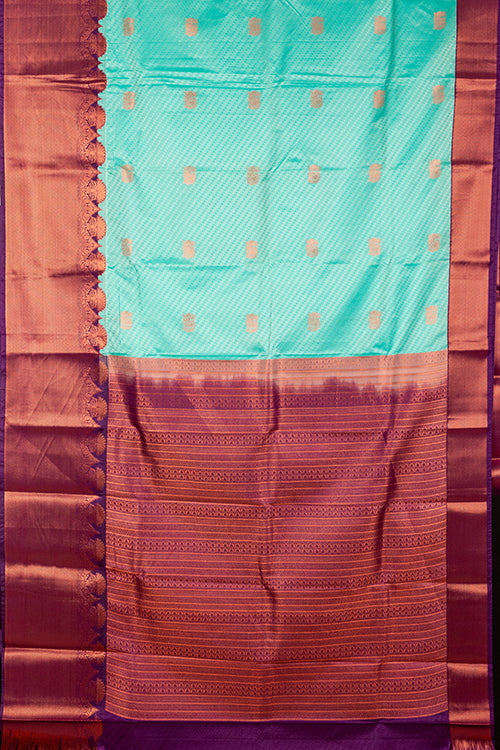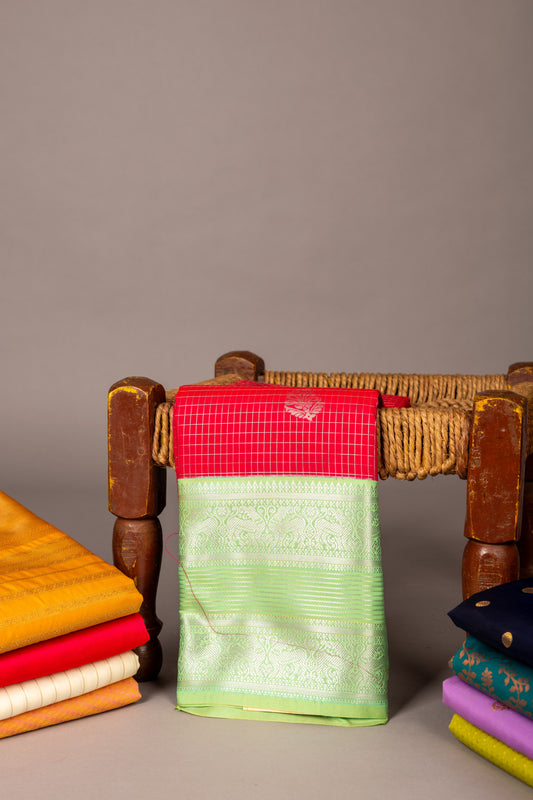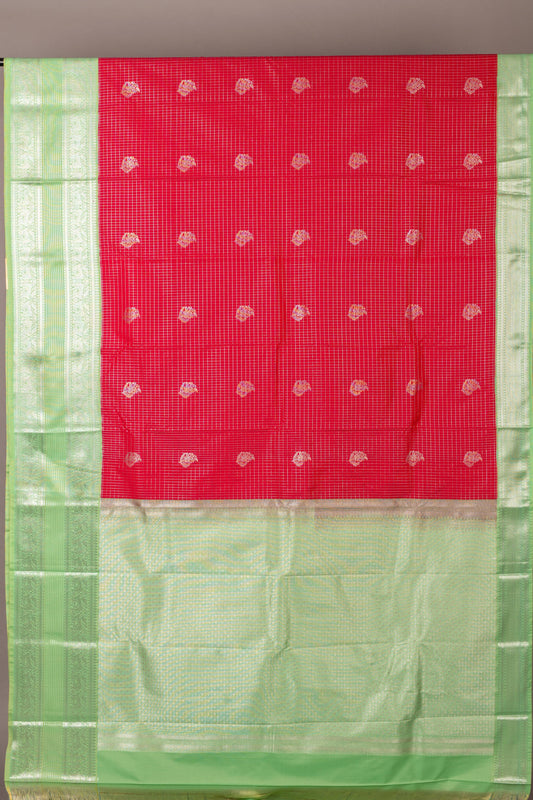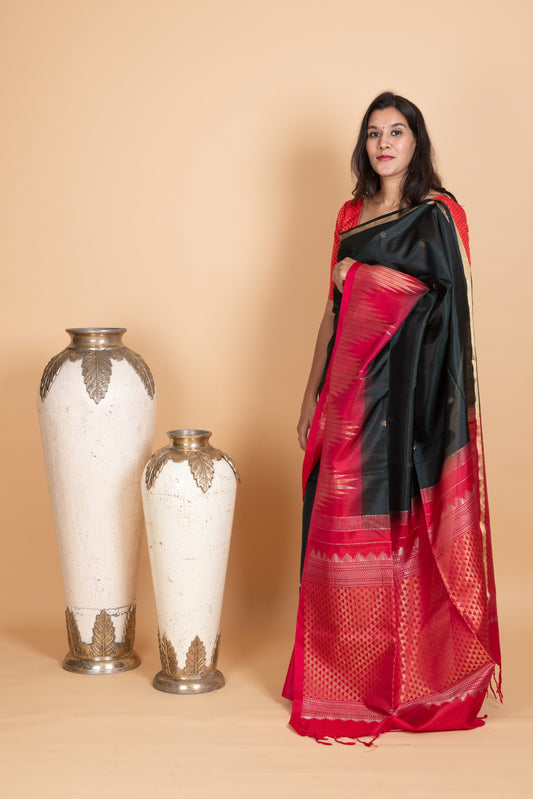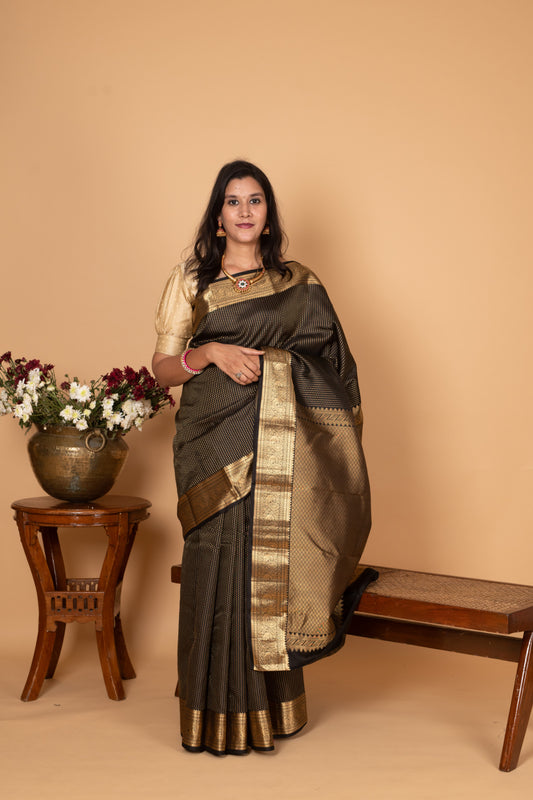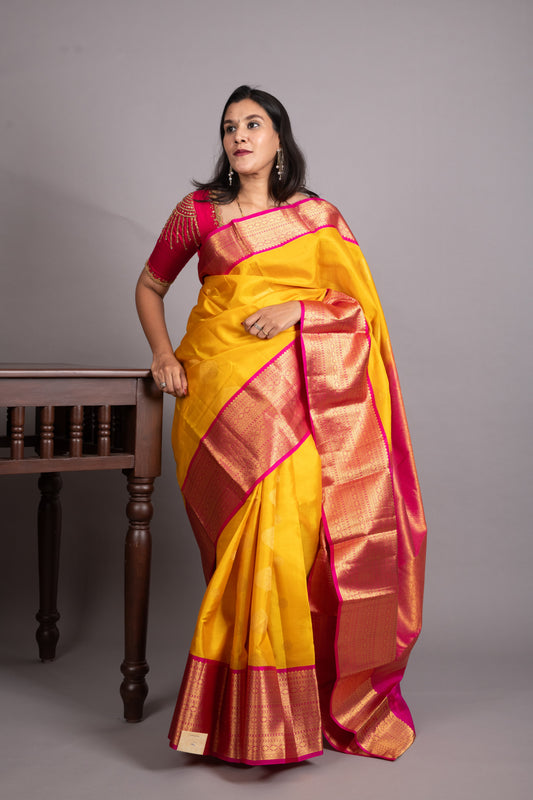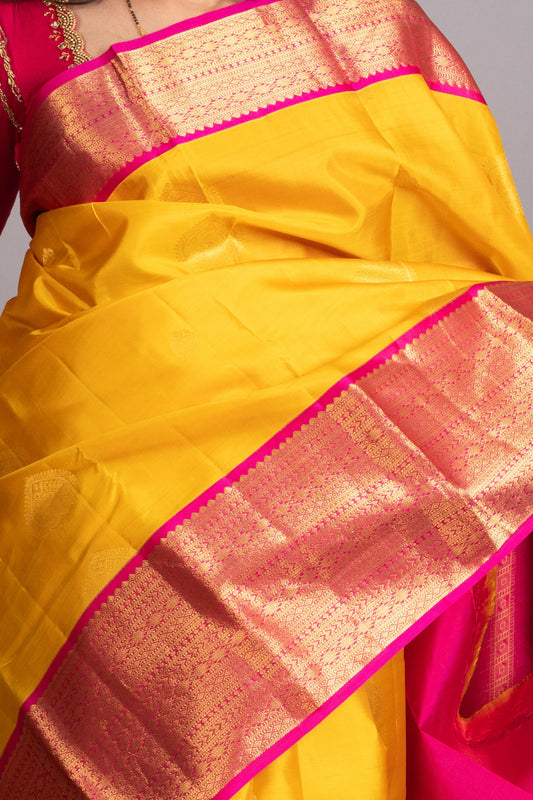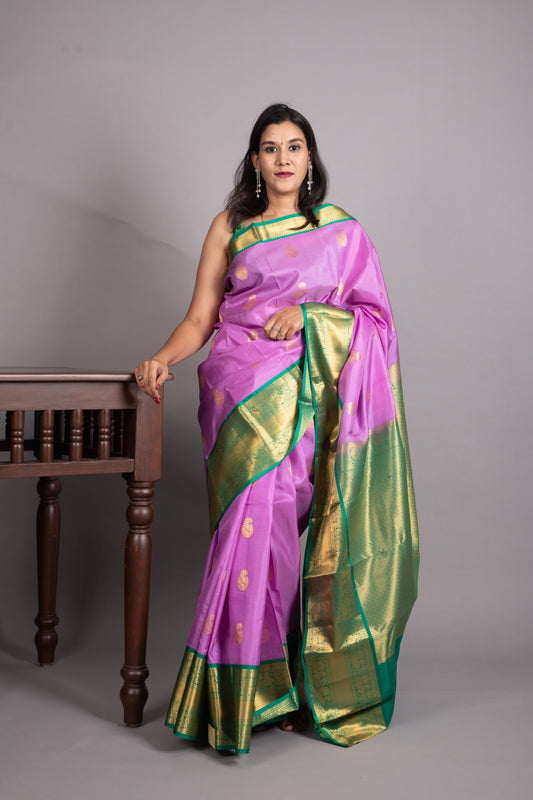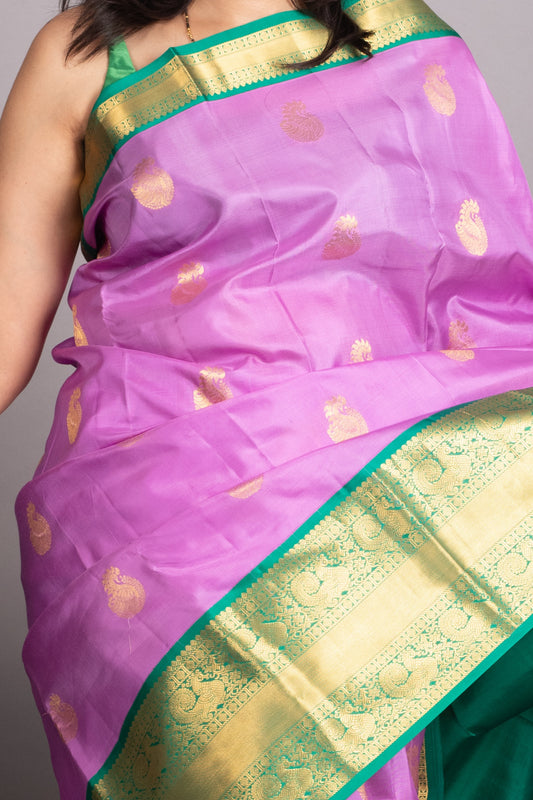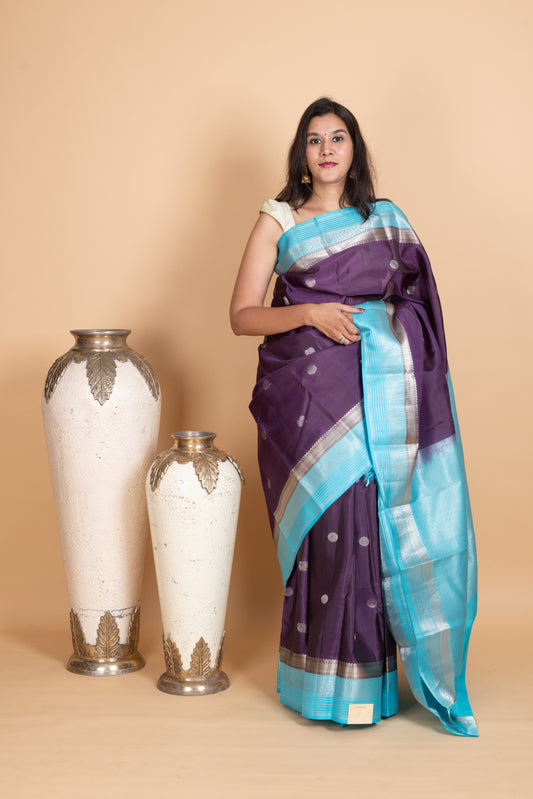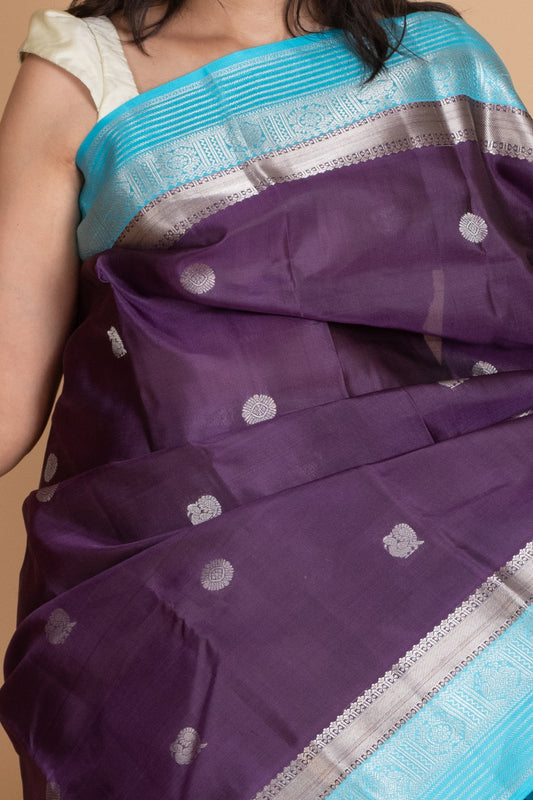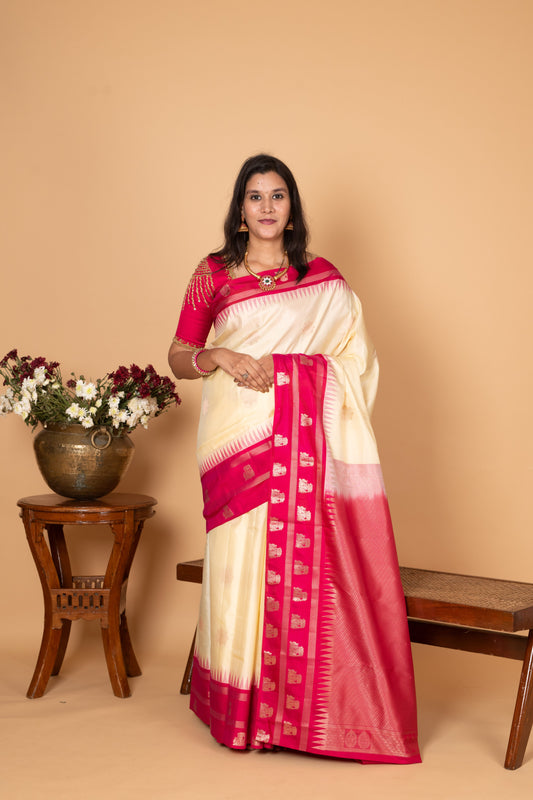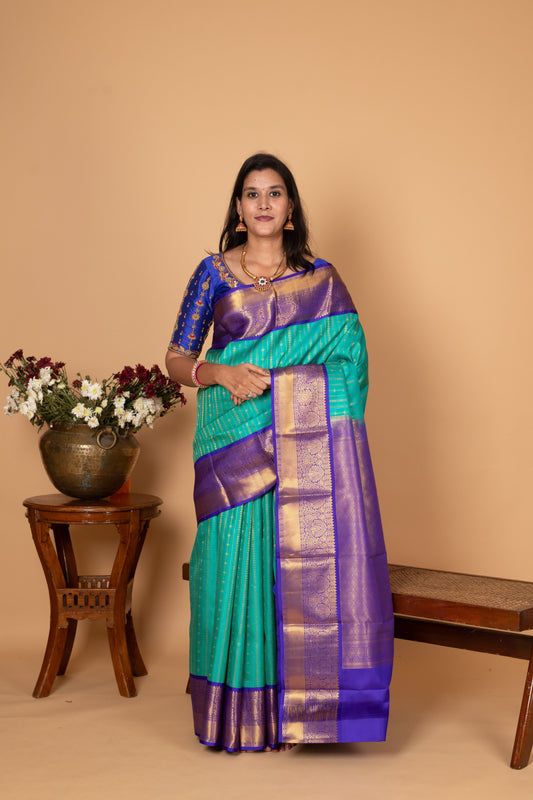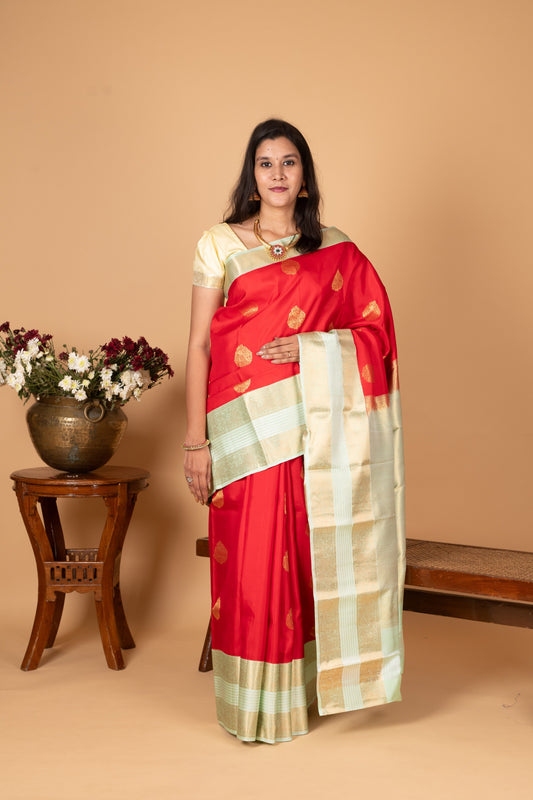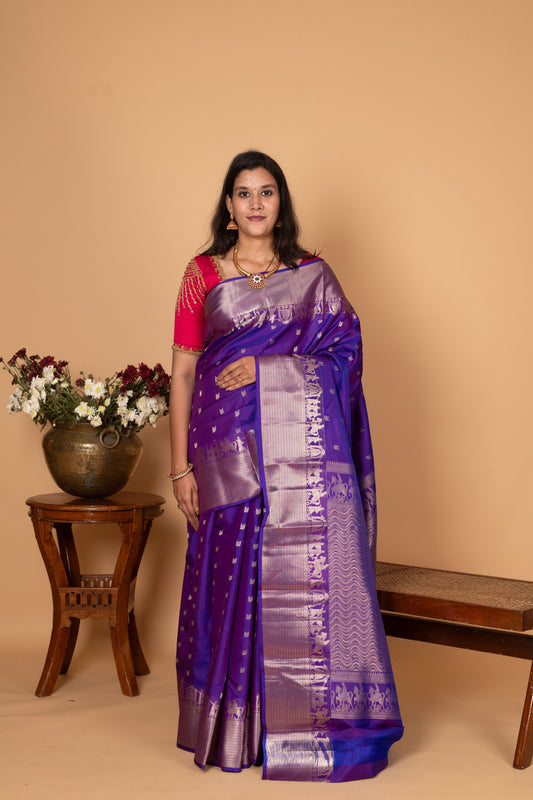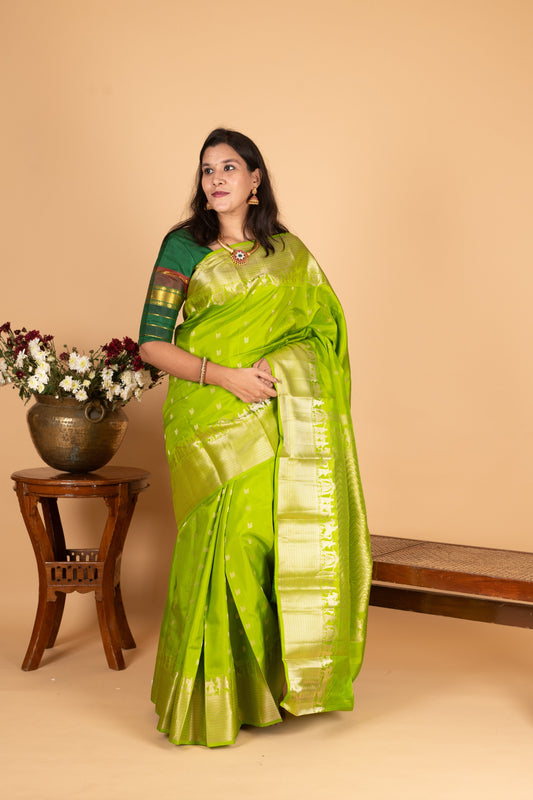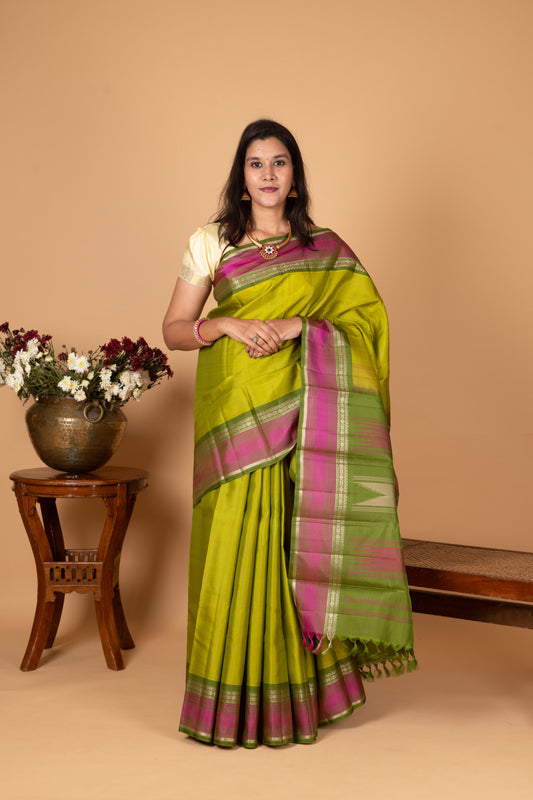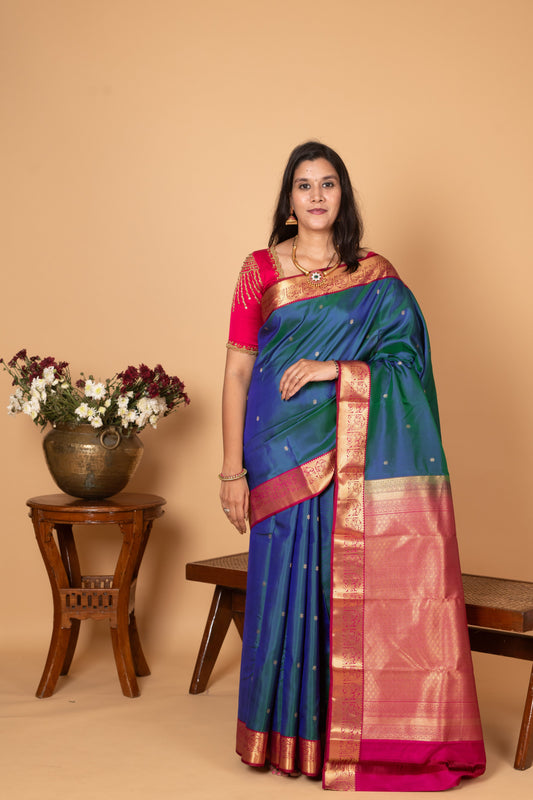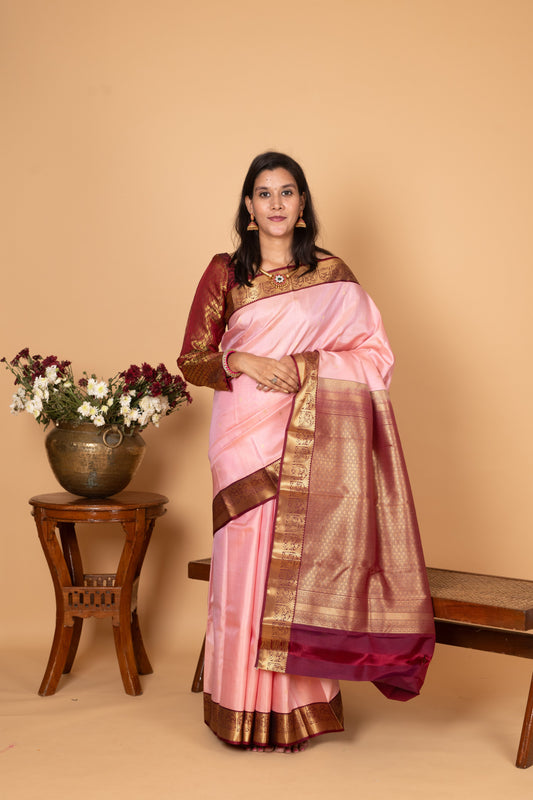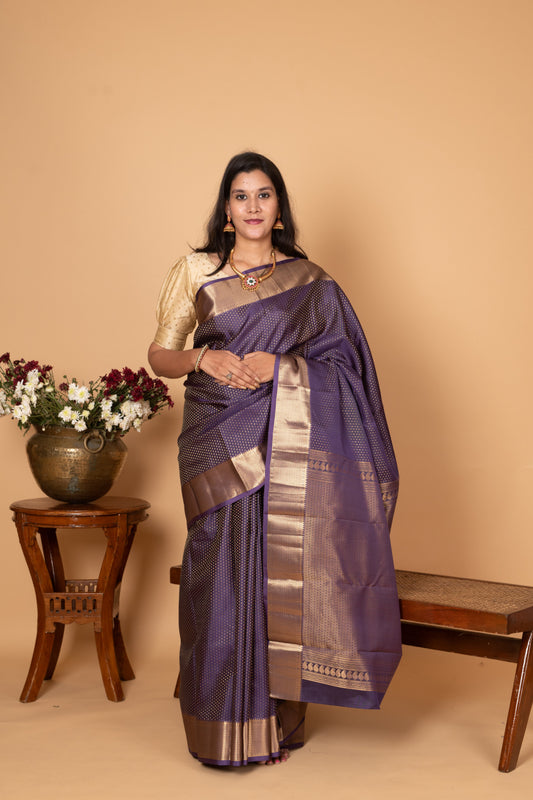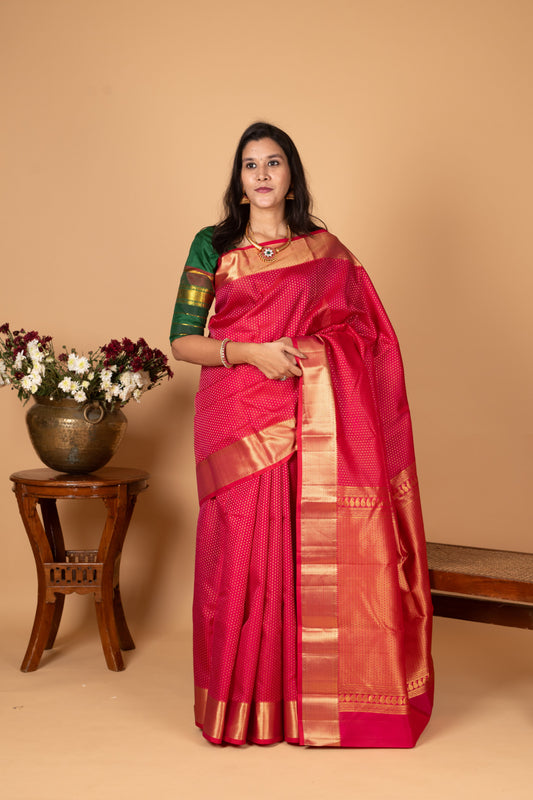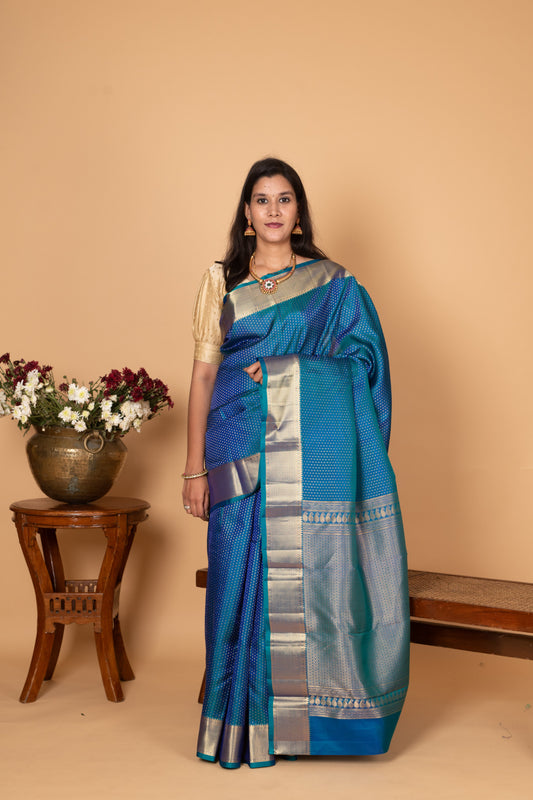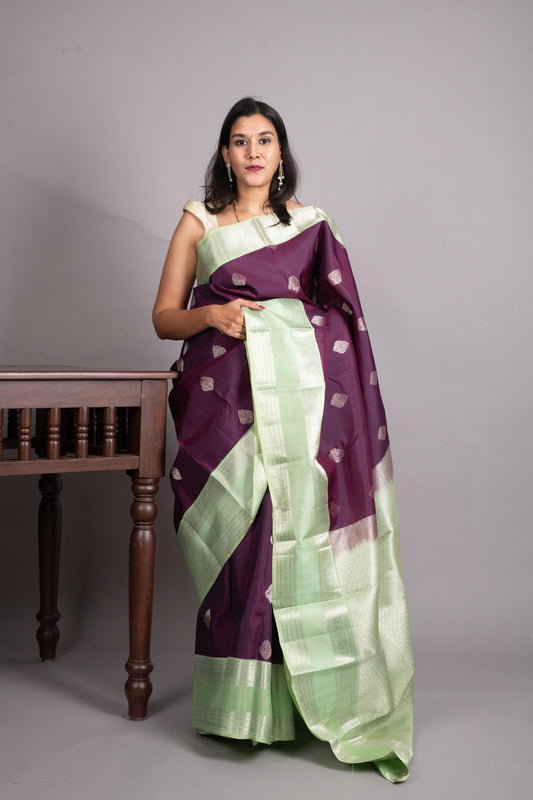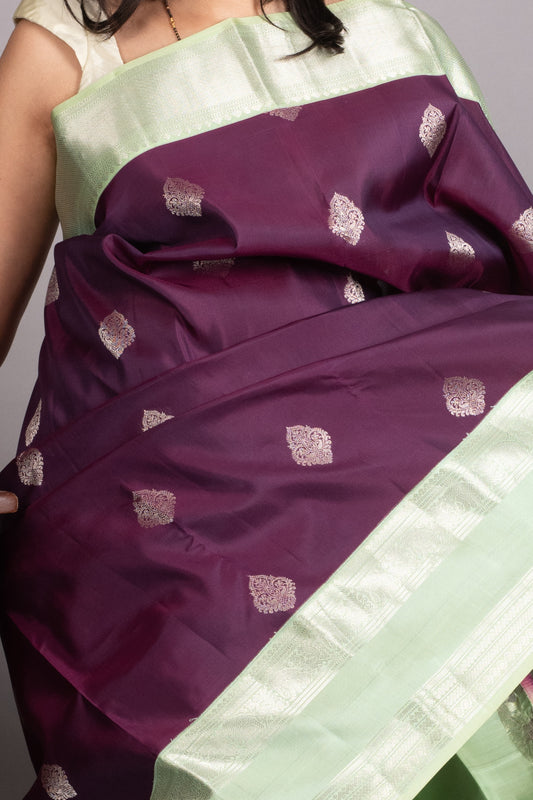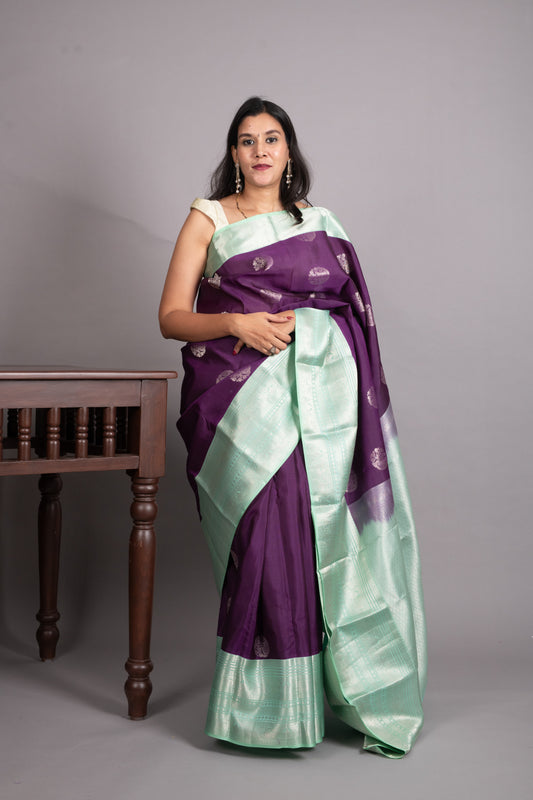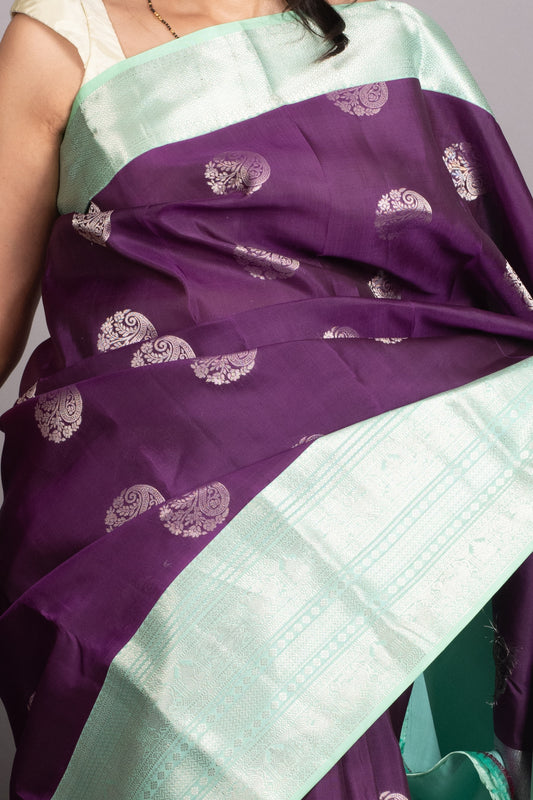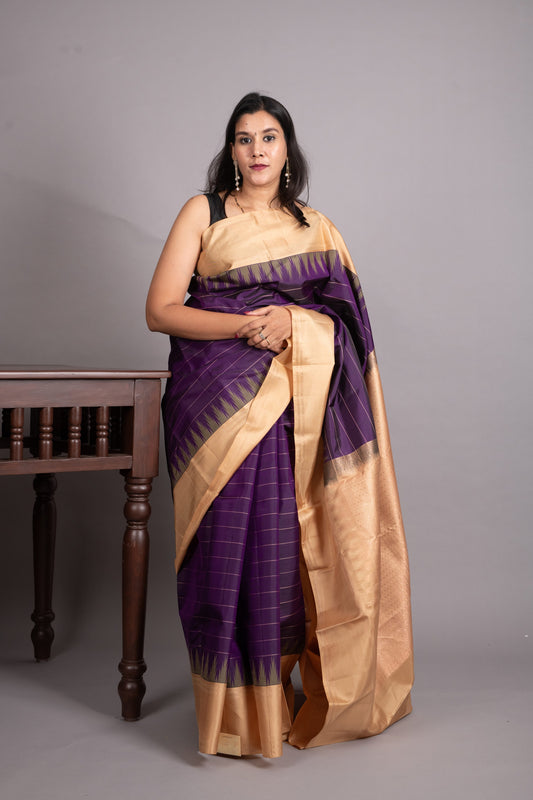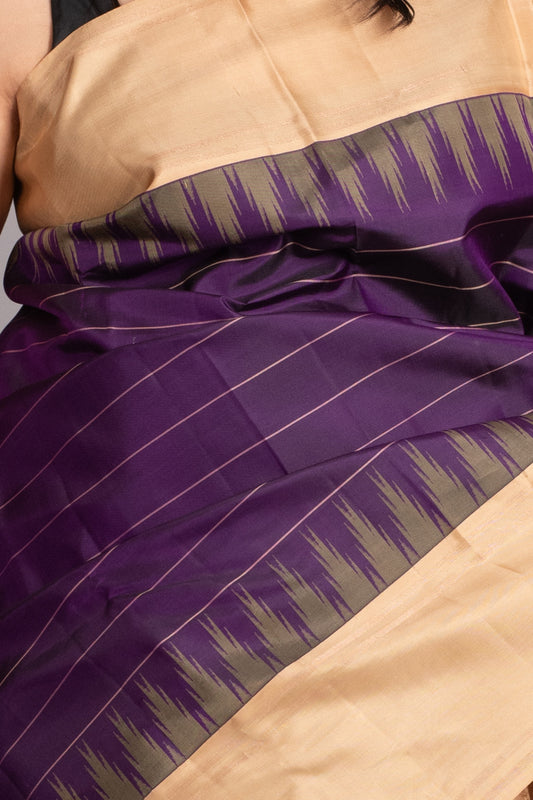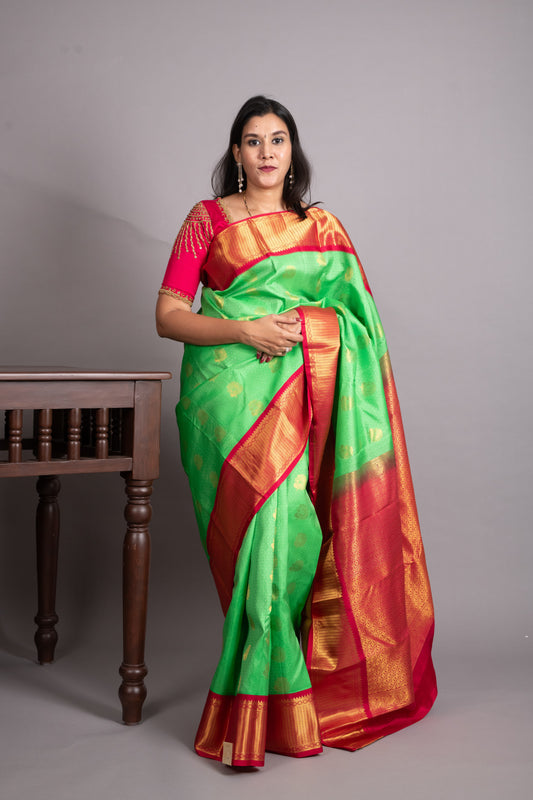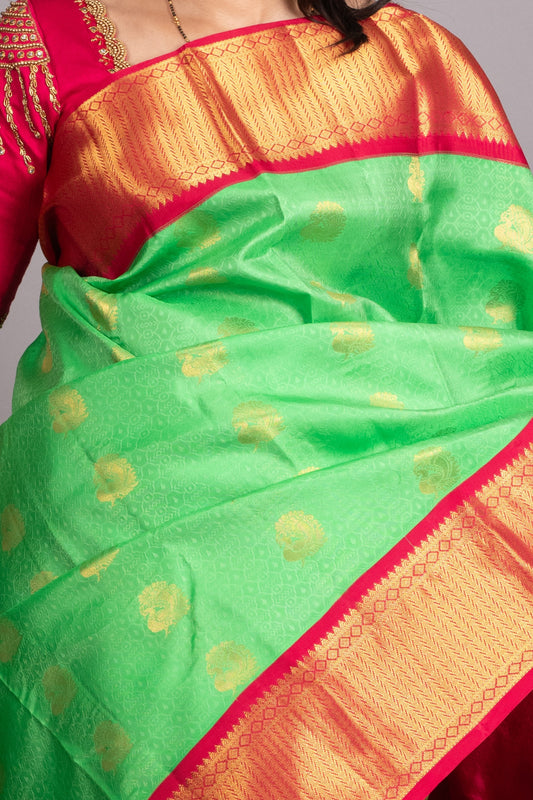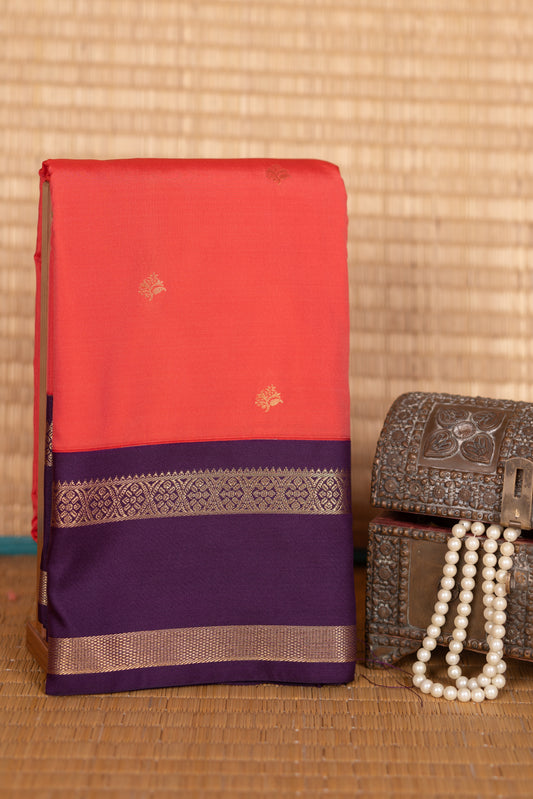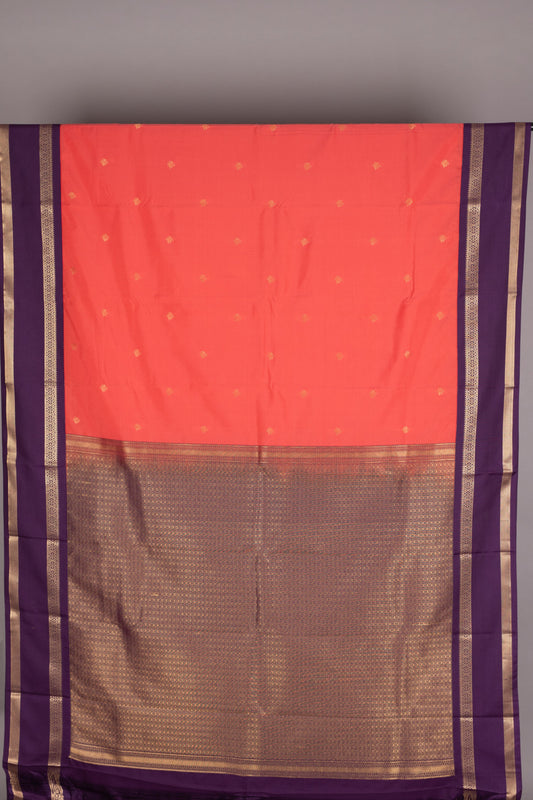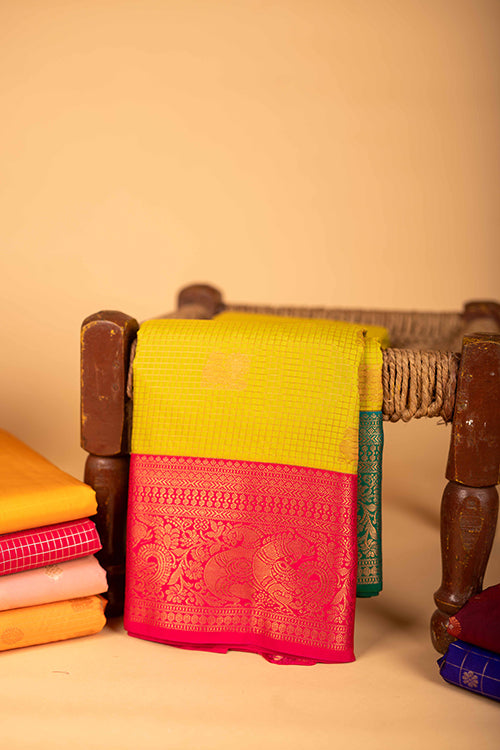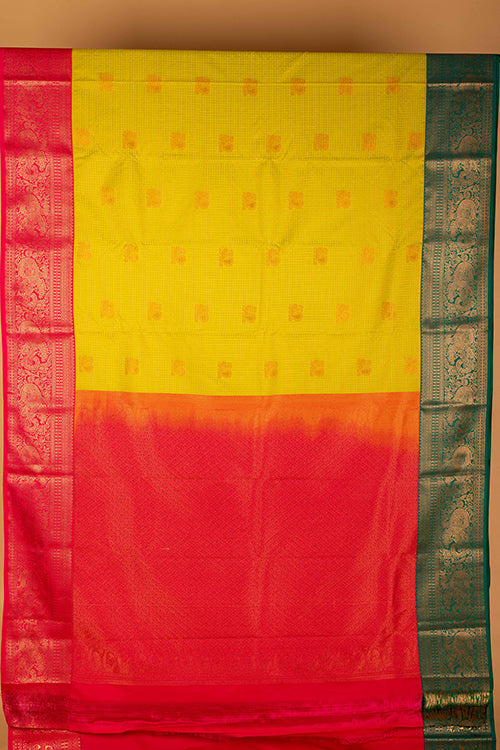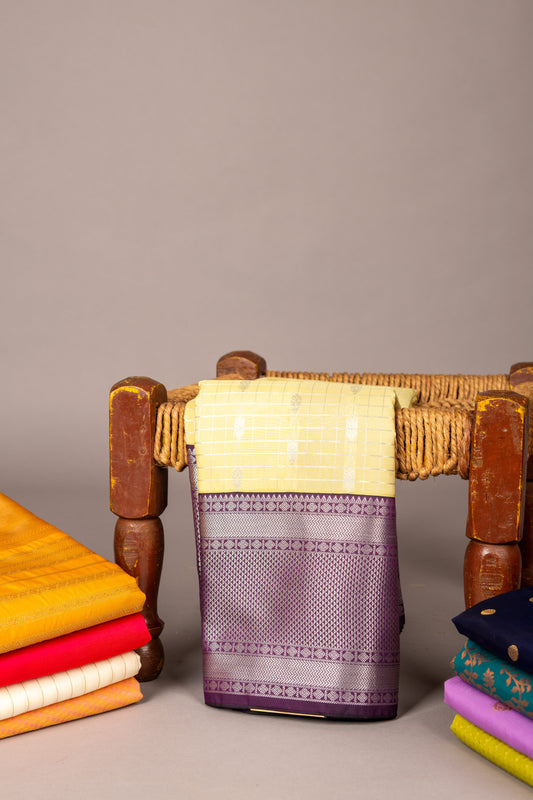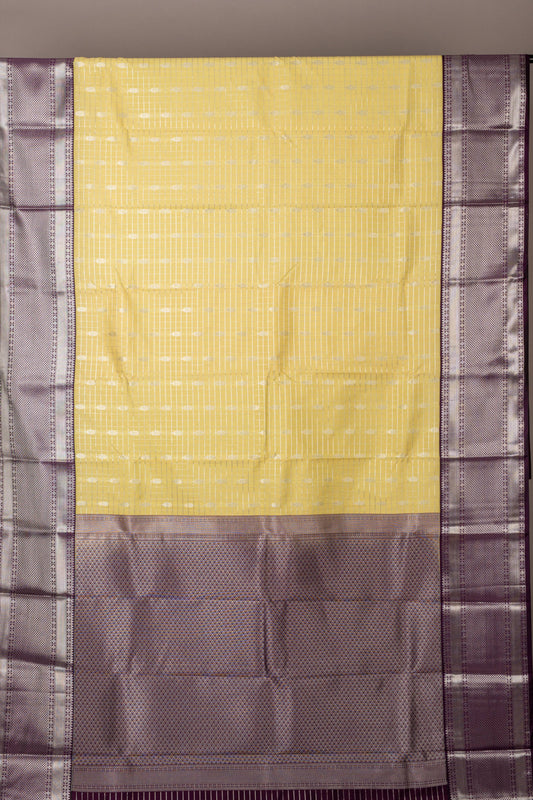Introduction
In the colourful tapestry of Indian culture, silk sarees hold a special place, captivating hearts with their opulent beauty and timeless elegance. Woven with intricate craftsmanship, these luxurious drapes have been an integral part of Indian tradition for centuries, reflecting the subcontinent's diverse heritage and rich artistry. Each region of India boasts unique silk saree varieties adorned with exquisite motifs and embellishments. In this blog, we will embark on a delightful journey exploring the different types of silk sarees, their origins, and the craftsmanship that makes them so revered.
1. Banarasi Silk Sarees
We begin our journey in the northern plains of India, in the holy city of Varanasi, where the splendid Banarasi silk sarees have been woven for centuries. These sarees are known for their heavy gold and silver brocade work, intricate designs inspired by Mughal art, and a lustrous sheen that gives them a regal appearance. Often worn by brides during weddings and grand occasions, Banarasi silk sarees symbolise luxury and grace.
Types of Banarasi Silk Sarees:
There are several types of Banarasi silk sarees, each with unique characteristics. Some of the most popular types include:
Katan Silk:
Made from pure silk threads, Katan silk sarees have a smooth texture and a plain weave. They are often adorned with intricate zari work and are known for their elegance.
Organza Silk:
These sarees are lightweight and transparent, made from organza silk. They feature delicate zari work and are popular choices for formal occasions.
Georgette Silk:
Georgette Banarasi sarees are lighter than traditional silk sarees, making them more comfortable to wear. They often feature a mix of silk and zari, creating a unique look.
Shattir Silk:
Shattir silk sarees have a satin-like texture and are known for their softness and elegance. They are adorned with elaborate zari work, making them suitable for grand celebrations.
2. Kanjivaram Silk Sarees
Travelling to the southern state of Tamil Nadu, we encounter the legendary Kanjivaram silk sarees, hailed as the "Queen of Silks." Renowned for their vibrant colours and wide borders with contrasting patterns, Kanjivaram sarees are a hallmark of South Indian weddings and celebrations. The pure mulberry silk used in their weaving and intricate zari work lends a richness and durability that make these sarees highly cherished heirlooms.

Types of Kanjivaram Silk Sarees
Traditional Kanjivaram Sarees:
These sarees epitomise the classic Kanjivaram style. They are characterized by their bold and vibrant colours, wide borders, and intricate zari work. The pallu of the saree is usually adorned with traditional motifs such as peacocks, elephants, checks, and temple designs, which are inspired by the rich cultural heritage of Tamil Nadu.
Korvai Kanjivaram Sarees:
Korvai sarees are unique because they are woven using two silk sarees and then interlocked with contrasting borders. The body of the saree is made with one colour or design, while the border and pallu are made with another, creating a striking contrast.
Gadwal Kanjivaram Sarees:
Gadwal sarees are a fusion of Kanjivaram and Gadwal styles. These sarees have a silk body, while the borders and pallu are woven with cotton, creating a lightweight and comfortable drape.
Reversible Kanjivaram Sarees:
As the name suggests, these sarees can be worn on both sides due to the weaving technique. Each side features a distinct design, making it a versatile and unique choice for saree enthusiasts.
Half-and-Half Kanjivaram Sarees:
Half-and-Half sarees have a distinctive style where one half is woven with one design or colour, while the other half features a contrasting design or hue. This creates a captivating and artistic look.
Checks and Stripes Kanjivaram Sarees:
These sarees feature a checkered or striped pattern throughout the body, border, and pallu. The intricate checks and stripes add a contemporary touch to the traditional Kanjivaram style.
Temple Border Kanjivaram Sarees:
As the name suggests, these sarees have a border design inspired by the architectural elements of temples. The border features intricate motifs of deities, temples, and other religious symbols.
Anniversary Kanjivaram Sarees:
These sarees are specially woven for milestone occasions such as weddings and anniversaries. They often feature elaborate zari work and grand designs, making them perfect for celebratory events.
Lightweight Kanjivaram Sarees:
For those seeking a lighter drape, lightweight Kanjivaram sarees are famous. They are woven with less heavy zari work, making them comfortable yet elegant for various occasions.
3. Patola Silk Sarees
From the vibrant state of Gujarat comes the mesmerizing Patola silk sarees, crafted using the double-ikat technique, where both warp and weft threads are tie-dyed before weaving. This labour-intensive process results in symmetrical patterns on both sides of the fabric, creating an exquisite visual spectacle. Patola sarees often feature geometric designs and are considered a status symbol among discerning saree connoisseurs.

Types of Patola Silk Sarees
Rajkot Patola:
Rajkot Patola sarees are one of the most famous varieties of Patola sarees. They come in vibrant colours and are adorned with intricate geometric patterns, including checks, stripes, and diamond motifs. Rajkot Patola sarees are known for their vibrant colour combinations, making them a favourite among saree connoisseurs.
Patan Patola:
Patan Patola sarees are considered the most authentic and premium among all Patola sarees. They are handwoven by skilled artisans in the town of Patan in Gujarat. Patan Patola sarees are known for their elaborate designs and complex patterns, often featuring peacocks, elephants, and other traditional motifs. These sarees are highly prized for their intricate craftsmanship and rich heritage.
Double Ikat Patola:
As the name suggests, Double Ikat Patola sarees involve a double-ikat weaving technique, where both the warp and weft threads are dyed in intricate patterns before weaving. This challenging and time-consuming process requires exceptional skill and precision, resulting in a saree with symmetrical and harmonious designs.
Single Ikat Patola:
Single Ikat Patola sarees are relatively simpler to weave compared to double Ikat sarees. In this technique, only either the warp or the weft threads are resist-dyed before weaving, while the other set of threads remains plain. Though less intricate, single ikat Patola sarees still exhibit beautiful designs and are cherished for their elegance.
Gharchola Patola:
Gharchola Patola sarees are traditional bridal attire in Gujarat. They are distinguished by their bright red colour and extensive square checks, often adorned with zari work. These sarees are considered auspicious and are worn by brides during weddings and special occasions.
Navratri Patola:
As the name suggests, these Patola sarees are worn during the vibrant festival of Navratri in Gujarat. They are characterized by their vibrant colours, intricate designs, and lightweight texture, making them perfect for festive celebrations.
Kadiyal Patola:
Kadiyal refers to the extra-weft technique used in weaving these sarees. This technique involves adding extra silk threads to create raised patterns, adding a three-dimensional texture to the saree. Kadiyal Patola sarees are highly sought after for their unique appearance.
4. Chanderi Silk Sarees
Nestled in the heart of India, the town of Chanderi in Madhya Pradesh is celebrated for its lightweight and sheer Chanderi silk sarees. These sarees are characterized by their delicate, luxurious texture and subtle, sophisticated motifs. Fine silk combined with cotton or zari borders adds to their charm, making them an ideal choice for summer festivities.

Types of Chanderi Silk Sarees
Chanderi Cotton Silk Sarees:
These sarees are a blend of silk and cotton, resulting in a soft and breathable fabric. Chanderi cotton silk sarees are perfect for everyday wear and casual occasions. They often feature simple and elegant designs with minimal zari work.
Chanderi Silk Cotton Zari Sarees:
In this variety, silk and cotton are blended with a touch of zari (metallic thread) to add a hint of glamour to the sarees. These sarees strike a balance between traditional elegance and contemporary style, making them suitable for both formal and semi-formal occasions.
Chanderi Silk Sarees with Butis:
Butis refer to small, repetitive motifs scattered across the saree's body. Chanderi Silk Sarees with Butis feature these delicate motifs, which could be floral, paisley, or geometric patterns, giving the saree a graceful and sophisticated look.
Chanderi Silk Sarees with Brocade:
Chanderi Silk Sarees with brocade work are adorned with intricate designs woven using zari threads. The brocade patterns often include peacocks, lotuses, and traditional Indian motifs, adding opulence and richness to the saree.
Chanderi Maheshwari Silk Sarees:
Maheshwari silk sarees are a blend of Chanderi silk and cotton. They are known for their reversible borders, where the saree can be draped with either side of the border facing up. The borders often feature contrasting colours and intricate designs.
Chanderi Organza Silk Sarees:
Chanderi Organza Silk Sarees have a lightweight and transparent texture due to the use of organza silk. These sarees are often embellished with delicate zari work and are suitable for formal and festive occasions.
Chanderi Silk Sarees with Gold Zari:
These sarees have generous use of gold zari in the borders, pallu, and body, adding a touch of opulence and grandeur to the overall look. Chanderi Silk Sarees with Gold Zari are preferred for weddings and special celebrations.
Chanderi Block Printed Silk Sarees:
Block printing is a traditional technique used to create intricate patterns on sarees. Chanderi Silk Sarees with block prints feature exquisite designs, adding a touch of artistry to the fabric.
Chanderi Silk Sarees with Silk Brocade Borders:
These sarees have a combination of silk and brocade work on the borders, creating a beautiful contrast. The silk brocade borders often feature intricate patterns and motifs, making the saree visually appealing.
Chanderi Silk Sarees with Gota Patti:
Gota Patti is a traditional Indian embroidery technique where strips of metallic ribbon are stitched onto the fabric to create elaborate designs. Chanderi Silk Sarees with Gota Patti work are famous during festive and wedding seasons.
5. Mysore Silk Sarees
Karnataka's cultural capital, Mysore, boasts splendid silk sarees known for their softness, intricate jacquard designs, and vibrant colours. These sarees often feature patterns inspired by nature, such as birds, animals, and flowers, reflecting the region's rich cultural heritage. Mysore silk sarees are favoured by women for formal and casual occasions, owing to their comfort and elegance.

Types of Mysore Silk Sarees
Pure Mysore Silk Sarees:
Pure Mysore Silk Sarees are made from 100% pure silk, which gives them a luxurious and lustrous appearance. They are soft to the touch and drape beautifully, making them a preferred choice for special occasions and weddings.
Mysore Crepe Silk Sarees:
Mysore Crepe Silk Sarees are woven using a crepe weaving technique, which gives the saree a slightly textured surface. These sarees are lightweight and have a fluid drape, making them comfortable to wear for extended periods.
Mysore Georgette Silk Sarees:
Mysore Georgette Silk Sarees are crafted from georgette silk, which is a lightweight and semi-transparent fabric. They are known for their delicate appearance and are often adorned with intricate zari work.
Mysore Silk Sarees with Zari Border:
These sarees have a zari border running along the edges, often featuring intricate designs and patterns. The zari work adds a touch of grandeur to the saree, making it suitable for formal events and celebrations.
Mysore Silk Sarees with Embroidery:
Embroidered Mysore Silk Sarees feature delicate threadwork or zari embroidery on the body, borders, or pallu. The embroidery could be in the form of floral motifs, peacocks, or other traditional patterns.
Mysore Silk Sarees with Temple Designs:
These sarees are adorned with temple-inspired designs, including intricate motifs of deities, temple towers, and traditional architecture. Temple designs add a sense of spirituality and cultural richness to the saree.
Mysore Silk Sarees with Block Prints:
Block printing is a traditional technique used to create beautiful patterns on the fabric. Mysore Silk Sarees with block prints often feature geometric or nature-inspired designs.
Mysore Silk Sarees with Jacquard Weave:
Jacquard weaving is a sophisticated technique used to create intricate patterns and designs on the saree. Mysore Silk Sarees with jacquard weave are known for their exquisite craftsmanship.
Mysore Silk Sarees with Contrast Pallu:
In this type of saree, the pallu (the loose end of the saree that drapes over the shoulder) is woven with a contrasting colour, creating an eye-catching effect.
Mysore Silk Sarees with Dual-tone Borders:
These sarees have borders with two different colours or shades, adding a touch of uniqueness and elegance to the saree.
6. Bhagalpuri Silk Sarees
Bhagalpur, renowned for its Bhagalpuri silk sarees, lies in the eastern state of Bihar. Their unique texture and exceptional resilience characterize these sarees. Also known as Tussar silk sarees, they are usually adorned with tribal-inspired motifs and come in earthy hues. Bhagalpuri silk sarees are celebrated for their simplicity and symbolise rural craftsmanship.

Types of Bhagalpuri Silk Sarees
Plain Bhagalpuri Silk Sarees:
These sarees are crafted with a simple and elegant plain weave, allowing the natural beauty of Tussar silk to shine through. The rich, earthy tones of Tussar silk give these sarees a rustic and ethnic charm.
Embroidered Bhagalpuri Silk Sarees:
Embroidered Bhagalpuri Silk Sarees feature delicate threadwork or zari embroidery on the borders, pallu, or body of the saree. The embroidery could be in the form of floral patterns, motifs, or intricate designs, adding a touch of sophistication to the saree.
Printed Bhagalpuri Silk Sarees:
Printed Bhagalpuri Silk Sarees have beautiful patterns and designs printed on the fabric. These sarees often feature nature-inspired motifs, geometrical patterns, or traditional Indian designs.
Kalamkari Bhagalpuri Silk Sarees:
Kalamkari is a traditional hand-painted or block-printed textile art form. Kalamkari Bhagalpuri Silk Sarees are adorned with intricate Kalamkari designs, depicting scenes from mythology or nature.
Bhagalpuri Silk Sarees with Contrast Border:
These sarees have a contrasting colour border, which adds a pop of colour and makes the saree visually appealing.
Bhagalpuri Silk Sarees with Resham Work:
Resham, or silk thread, work is used to create intricate patterns on the saree. Bhagalpuri Silk Sarees with Resham work are known for their artistic and vibrant appearance.
Bhagalpuri Silk Sarees with Block Prints:
Block printing is a traditional technique used to create beautiful patterns on the saree. Bhagalpuri Silk Sarees with block prints often feature geometric or floral designs.
Bhagalpuri Silk Sarees with Zari Work:
Zari work involves weaving metallic threads into the fabric to create intricate designs. Bhagalpuri Silk Sarees with zari work have a touch of glamour and are often worn for special occasions.
Bhagalpuri Silk Sarees with Traditional Motifs:
These sarees are adorned with traditional Indian motifs such as peacocks, elephants, lotuses, and paisleys, adding a touch of cultural heritage to the saree.
Bhagalpuri Silk Sarees with Digital Prints:
Digital printing technology is used to create intricate and vibrant patterns on the saree. Bhagalpuri Silk Sarees with digital prints offer a contemporary and trendy look.
7. Paithani Silk Sarees
Venturing Maharashtra, we encounter the resplendent Paithani silk sarees adorned with intricate peacock and lotus motifs, reflecting the artistic grandeur of the Ajanta and Ellora caves. These sarees are crafted with a unique weaving technique, wherein the zari work is woven into the fabric, making them a sight to behold. Paithani silk sarees are cherished as heirlooms and are worn during auspicious occasions in Maharashtra.

Types of Paithani Silk Sarees
Traditional Paithani Sarees:
These sarees are crafted in the classic Paithani style, featuring intricate zari work and motifs inspired by nature and traditional art forms. Traditional Paithani Sarees are often adorned with peacocks, parrots, lotuses, and other floral and bird motifs, reflecting the rich cultural heritage of Maharashtra.
Border Paithani Sarees:
Border Paithani Sarees have a distinctive border design, usually with a contrasting colour to the body of the saree. The border is intricately woven with zari, adding a touch of opulence and elegance to the overall look.
Buti Paithani Sarees:
Buti refers to small, repetitive motifs scattered across the saree's body. Buti Paithani Sarees feature these delicate motifs, often in the form of floral or paisley patterns, creating a subtle yet captivating look.
Bangadi Border Paithani Sarees:
The Bangadi border is a unique feature of these sarees. The border has a distinct shape, resembling a bangle (bangadi), and is intricately woven with zari work, making it a signature element of Bangadi Border Paithani Sarees.
Asawali Paithani Sarees:
Asawali refers to a specific type of peacock motif that is featured prominently in these sarees. Asawali Paithani Sarees showcase beautiful peacock designs in the pallu and borders, symbolizing beauty, grace, and love.
Narali Paithani Sarees:
Narali, meaning coconut, refers to the coconut tree motif that is often woven into these sarees. Narali Paithani Sarees celebrate the coastal regions of Maharashtra and are favoured for festive and cultural occasions.
Ratancha Paithani Sarees:
Ratancha Paithani Sarees feature diamond-shaped motifs, representing sparkling jewels. The geometric patterns add a touch of elegance and charm to the saree.
Lotus Motif Paithani Sarees:
As the name suggests, these sarees prominently feature lotus motifs, symbolizing purity and beauty. Lotus Motif Paithani Sarees are revered for their artistic beauty and cultural significance.
Munia Brocade Paithani Sarees:
Munia refers to the bird "myna," and these sarees are adorned with intricate brocade work featuring Mynas. Munia Brocade Paithani Sarees are highly prized for their artistic appeal.
Half and Half Paithani Sarees:
In this type of saree, one-half of the body and pallu features one design or colour, while the other half showcases a different pattern or hue, creating a captivating and unique look.
8. Baluchari Silk Sarees
Moving eastwards to West Bengal, we discover the alluring Baluchari silk sarees featuring elaborate narrative designs inspired by ancient epics and mythology. Traditionally woven on jacquard looms, these sarees often depict scenes from the Ramayana and the Mahabharata. Baluchari silk sarees are a testament to the artistic prowess of Bengal's weavers and are coveted by saree enthusiasts nationwide.

Types of Baluchari Silk Sarees
Baluchari Silk Sarees with Mythological Motifs:
These sarees feature elaborate woven designs depicting scenes from Indian mythology, such as the Ramayana and the Mahabharata. The pallu of the saree is the highlight, showcasing detailed narratives of epic stories.
Baluchari Silk Sarees with Floral Motifs:
In these sarees, the pallu and borders are adorned with intricate woven floral patterns. The designs often include beautiful flowers like lotus, jasmine, and roses.
Baluchari Silk Sarees with Nature-Inspired Designs:
These sarees showcase motifs inspired by nature, such as trees, birds, animals, and scenic landscapes. The designs depict the beauty of the natural world and add a touch of serenity to the saree.
Baluchari Silk Sarees with Royal Court Scenes:
Some Baluchari Silk Sarees feature designs that depict royal court scenes, showcasing the grandeur of ancient kingdoms and palaces.
Contemporary Baluchari Silk Sarees:
While Baluchari Silk Sarees have a strong traditional appeal, contemporary versions may incorporate modern motifs and designs, appealing to a broader range of tastes and preferences.
Baluchari Silk Sarees with Geometric Patterns:
These sarees showcase intricate geometric patterns and designs, adding a contemporary touch to the traditional Baluchari style.
Baluchari Silk Sarees with Human Figures:
Some Baluchari sarees include designs featuring human figures, portraying dancers, musicians, or other aspects of traditional Indian culture.
Dual-tone Baluchari Silk Sarees:
In these sarees, the body and pallu have two contrasting colours, creating an eye-catching and vibrant effect.
Baluchari Silk Sarees with Resham Work:
Resham, or silk thread, work is used to enhance the woven designs on these sarees, adding depth and texture to the motifs.
Baluchari Silk Sarees with Zari Borders:
The sarees have zari borders, which add a touch of opulence and richness to the overall look.
Conclusion
In conclusion, silk sarees are not merely pieces of clothing but embody India's rich cultural heritage and artistic diversity. The craftsmanship, skill, and creativity that go into weaving each saree make them timeless treasures cherished by generations. From the regal Banarasi silk sarees to the enchanting Baluchari silk sarees, each variety tells a story deeply entwined with the history and traditions of the regions they hail from.
Whether you are a saree lover or someone exploring the beauty of Indian textiles, these silk sarees offer a glimpse into the soul of India's magnificent tapestry. The art of weaving these silken drapes continues to thrive, thanks to the dedicated efforts of skilled artisans who keep these traditions alive. As we celebrate the beauty and elegance of silk sarees, let us also honour the hands that weave magic into these timeless art pieces.
